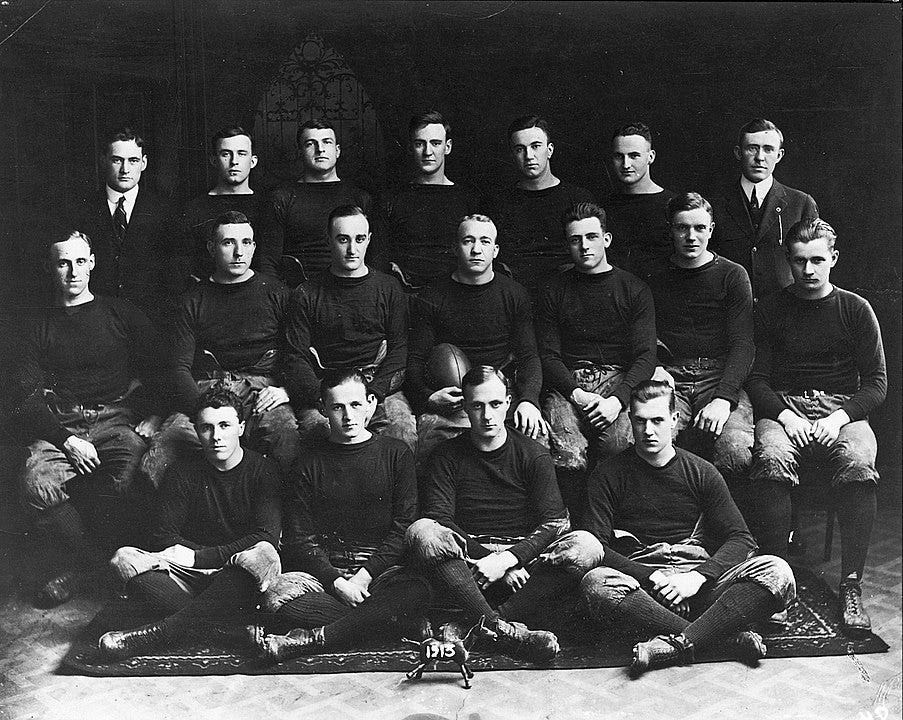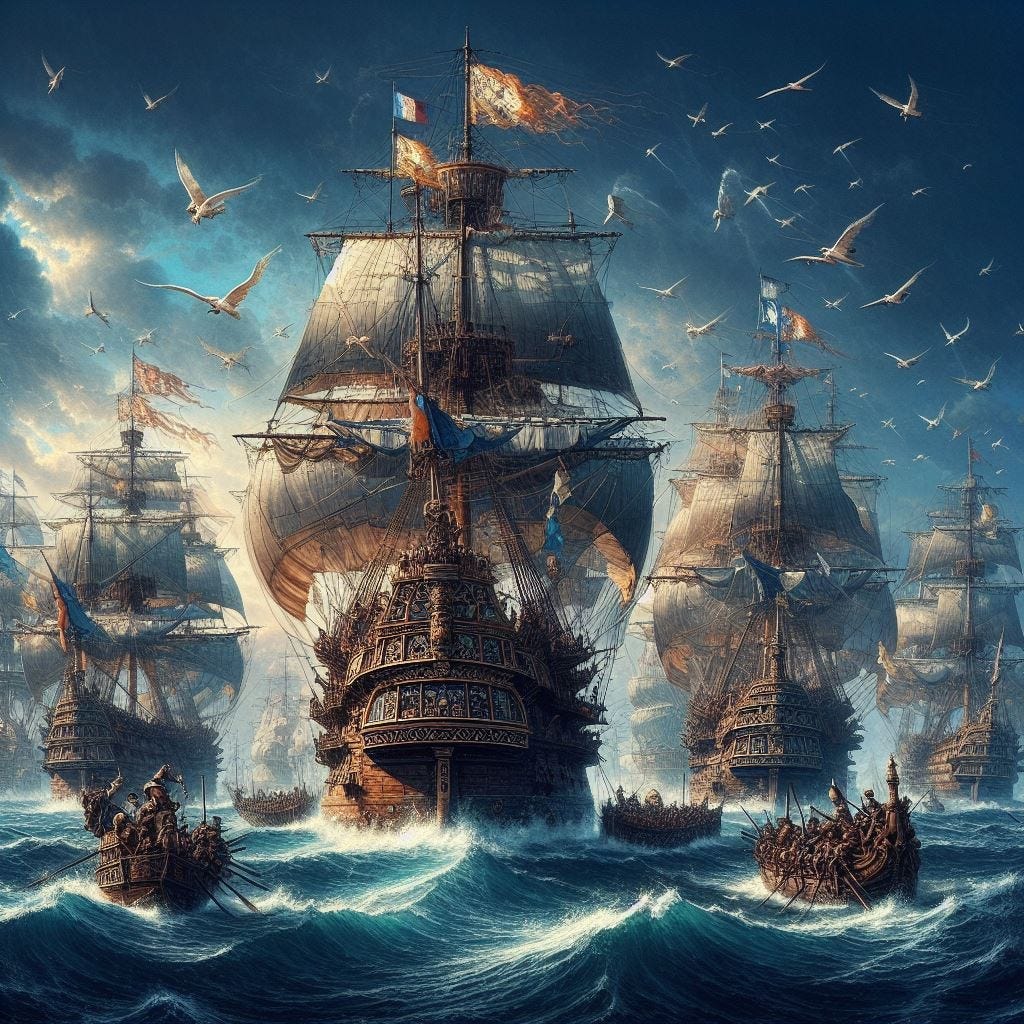[TLDR: Two distinct narratives, separated by time and oceans, tell the tales of the Army football team’s encounter with Notre Dame in 1913 and the Spanish Armada’s ill-fated expedition against the British Navy. These stories, seemingly unrelated, share a common thread — the transformative power of innovation in the face of tradition.]
“The best swordsman in the world doesn’t need to fear the second best swordsman in the world; no, the person for him to be afraid of is some ignorant antagonist who has never had a sword in his hand before; he doesn’t do the thing he ought to do, and so the expert isn’t prepared for him; he does the thing he ought not to do; and often it catches the expert out and ends him on the spot.” — Mark Twain
In 1912, the Notre Dame football program hung in the balance. Notre Dame faced a financial abyss, losing money in consecutive seasons. One significant factor contributing to the financial deficits was the reluctance of larger teams to play against Notre Dame, a poor Catholic college that was virtually unknown in the East. As a result, the university had to engage in matchups with smaller teams that had more modest fan bases.
It was in this environment that Notre Dame hired Jesse Harper for both his coaching and financial acumen. The new coach immediately sought to elevate the program’s fortunes. In 1913, a letter to West Point proved pivotal. Unwittingly, Coach Harper had set up one of the most important games in college football history. Armed with only 14 pairs of cleats for 19 players, Notre Dame embarked on a battle to face Army. In a David v Goliath matchup, the clash marked a turning point in the evolution of American football.

In his first season in charge, Coach Harper knew he couldn’t succeed with a traditional approach. The incumbent, Army was drilled in winning tactics. In 1913, the game was more akin to rugby. It was more about Braun than brains. Fortune favoured Notre Dame as they had mastered a revolutionary strategy — the forward pass.
In 1913, rule changes allowed teams to pass beyond the existing 20-yard limit. Notre Dame seized this regulatory change, unleashing a barrage of forward passes that overwhelmed Army. Touchdown after touchdown, the forward pass became not just an alternative but an entirely new strategic approach.
Notre Dame’s mastery of the forward pass created tactical asymmetry. While the Westerners effortlessly executed precise passes, Army, unfamiliar with this innovation, stood confounded. The game highlighted the disruptive power of adopting new strategies and showcased the struggle of an entrenched system to adapt
The national media’s East Coast bias inadvertently favoured Notre Dame and others in the Midwest. A lack of interest by the media allowed Notre Dame time to master the forward pass in relative obscurity. A fledgling team that had mastered new rules for a new era caught the might of successful and established teams off guard.
The lesson for the business arena is to master new regulations while dominating existing regulations. Don’t let your dominance blind you to the transformative impact of regulatory change.
Let’s go back even further in time to a different battlefront, where the British Navy, embraced strategic change rather than surfed the waves of regulatory change.
The Spanish Armada’s Defeat: Naval Innovation Triumphs
The defeat of the Spanish Armada in 1588 serves as a cautionary tale of the consequences of failing to recognise the value of embracing innovation in naval warfare. In 1588, Philip II, King of Spain, set as his personal mission the return of England to the Roman Catholic Church. Philip had the backing of the Vatican, who saw the invasion as a crusade for the Holy Roman Empire. With this support, Phillip was able to collect higher taxes to fund his preparations. No expense was spared in the preparations for the attack.

During this era, ships were viewed as mere transports for land armies, leading to the construction of massive, unwieldy “sea castles”. The Spanish Armada’s ships, designed to transport soldiers for land warfare tactics, struggled against the wind.
In contrast, English commanders like John Hawkyns and Sir Francis Drake revolutionised naval warfare. Hawkyns designed ships for superior windward performance. He didn’t care about cargo-carrying ability; his ships were designed to defeat the enemy at sea.
While Hawkyns innovated with design, Drake reinvented organisation. Until then, sea captains were entirely subservient to the land generals whom they served. Drake adopted a new strategy, the captain of the ship as the complete master of his vessel at sea. Drake established a specialised command structure. The outcome? A fleet capable of agile manoeuvres and efficient naval tactics. The result? One of the most humiliating military debacles in history.
As the Spanish Armada sailed up the English Channel, the Spanish anticipated a traditional naval battle. They expected the English to use grappling hooks, archers, and boarding infantry. However, the English, under the strategic leadership of Drake, Hawkyns, and other captains, innovatively held the windward position. Always sailing upwind of their enemy, they seized control of the battle strategy, attacking when advantageous and strategically retreating when outgunned. Historic reports highlighted that the wind aided the victorious British, but there was no doubt that they had the perfect strategy for the conditions.
These tales of two battles, separated by centuries and circumstances, underline the enduring importance of innovation in the face of tradition. Whether on the football field or the high seas, the ability to adapt and embrace new strategies has proven pivotal in shaping the course of history.
[Notre Dame v Army: https://goldenrankings.com/ClashOfTitans1913.htm
Notre Dame v Army / Kaihan Krippendorf: https://amzn.eu/d/1iDReiF
Spanish Armada v British Navy / Lawrence Miller: https://amzn.eu/d/guZ4nDg ]
The latest episode of The Innovation Show with Kaihan Krippendorff is here:
Armada & Navy: Embracing Regulatory and Strategic Change was originally published in The Thursday Thought on Medium, where people are continuing the conversation by highlighting and responding to this story.